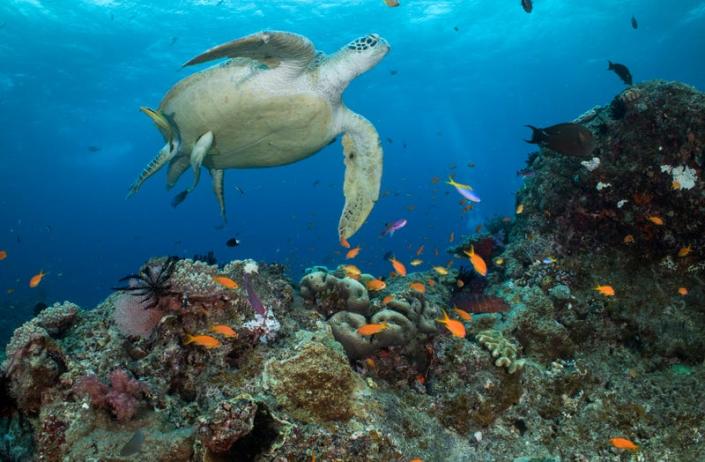
The Great Barrier Reef is home to over 9,000 known species, but in recent years and decades the reef’s health has declined dramatically.
The Great Barrier Reef is in danger and should be labeled with that official designation on the list of World Heritage sites, according to a joint assessment by the United Nations Educational, Scientific, and Cultural Organization (UNESCO) and the International Union for the Conservation of Nature (IUCN). The report, released Monday, describes an ecosystem in steep decline and at the mercy of rapidly warming oceans and inadequate protections.
However, the Australian government disagrees. The country’s Environment and Water Minister, Tanya Plibersek, said Tuesday that Australian leadership would lobby against the “in Danger” designation, based on recently enacted climate change and environmental policies.
Read more
“The new government has done more in this six months than the previous government did in nine years,” said Plibersek, blaming the previous government for much of the reef’s state. She began her role as Environment Minister under the recently elected, left-leaning Labor Party administration on June 1, 2022. Prior to May 2022, the more right-wing Liberal Party had been in power for more than eight years.
Once the Labor Party took over, they quickly implemented some big climate-focused policies. The new government has committed to a national goal of 43% emissions reduction below 2005 levels by 2030 (nearly two times the commitment of the previous government), as well as a net zero goal by 2050.
“We will very clearly make the point to UNESCO that there is no need to single the Great Barrier Reef out, in this way. The reason that UNESCO in the past has singled out places at risk is because they wanted to see greater government investment and greater government action, and since the change in government, both of those things have happened,” Plibersek explained.
“If the Great Barrier Reef is in danger, then every coral reef in the world is in danger. If this World Heritage site is in danger, then most World Heritage sites around the world are in danger from climate change,” she added. Which prompts the question of how useful such designations are in the face of planet-wide catastrophe.
There are 1,154 total UN World Heritage sites, 52 of which are considered “in Danger”—more than half of which are cultural sites in North Africa and the Middle East.
Yet, semantics aside, reef scientists and conservationists say the Labor Party’s actions are still not enough. “We are taking action, but that action needs to be much more rapid and much more urgent,” Jodie Rummer, a marine biologist at James Cook University in Townville, told the Australian Broadcasting Corporation, per the Associated Press. “We cannot claim to be doing all we can for the reef at this point. We aren’t.”
UNESCO has considered the “in Danger” label before for the Great Barrier Reef, as far back as 2014. However, according to the new report summary, the UN was dissuaded from doing so by Australia’s policy arguments. The country had a long-term sustainability plan, restricted port development, and stopped dumping dredge material near the reef. Yet, the reef’s decline continued.
Mass bleaching, once a rare occurrence, has trended toward becoming an annual event. In 2016, 2017, and 2020, ocean heatwaves bleached between 20% and 40% of the reef in each instance, damaging large swathes of the world’s most extensive reef ecosystem.
In March 2022, representatives from the UN’s World Heritage Center and the International Union for the Conservation of Nature visited the Great Barrier Reef and re-assessed revised Australian management plans. While they were there, another mass bleaching event occurred—the first ever recorded during a La Niña period, when the South Pacific Ocean should be cooler than normal.
The visiting UN reps determined that, despite the efforts in place, the reef was still “significantly impacted by climate change factors” and that “degraded water quality” remained a factor as well. Thus, the UN recommended that the Great Barrier Reef be listed as “in Danger.”
“The mission team acknowledges that the threat of climate change is a global threat requiring a global solution and underlines that it is critically important for all State Parties to undertake the most ambitious, rapid, and sustained implementation of the Paris Agreement,” said the report. The authors suggested that Australia take rapid action to reduce its emissions, in line with the 1.5 degree Celsius warming limit of the Paris Agreement. Though the current 43% reductions are bigger than previous promises, the goal remains far short of the 74% emissions cutes needed to avoid blowing past that 1.5 C benchmark, according to the Climate Targets Panel.
In addition, the report writers offered 10 further policy actions unrelated to climate that could make a difference. The UN and IUCN recommended strategies like expanding reef restoration, implementing better farming practices, protecting native vegetation, funding more reef research, and ending gill net fishing.
The Great Barrier Reef is Earth’s largest living structure and coral reef system, composed of more than 2,900 individual reefs and over 900 islands. It stretches nearly 1,500 miles long and spans about 133,000 square miles. The reef is home to thousands of species, but over the past 30 years, it has lost more than half its corals, according to one 2020 study.
The UN’s final decision on whether or not the Great Barrier Reef should be added to the “in Danger” list won’t be made until a 2023 World Heritage Committee meeting.
More from Gizmodo
Sign up for Gizmodo’s Newsletter. For the latest news, Facebook, Twitter and Instagram.




